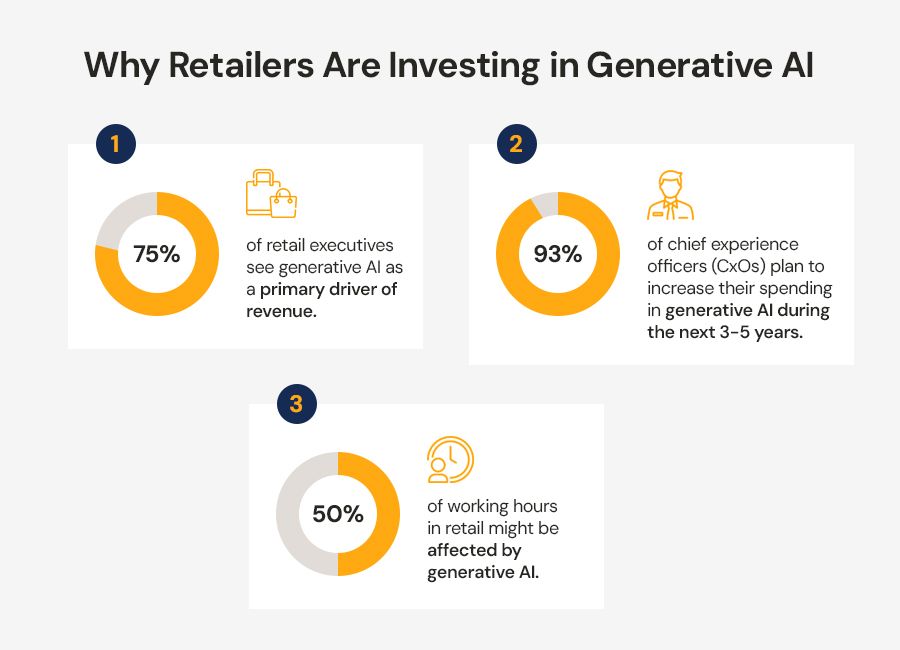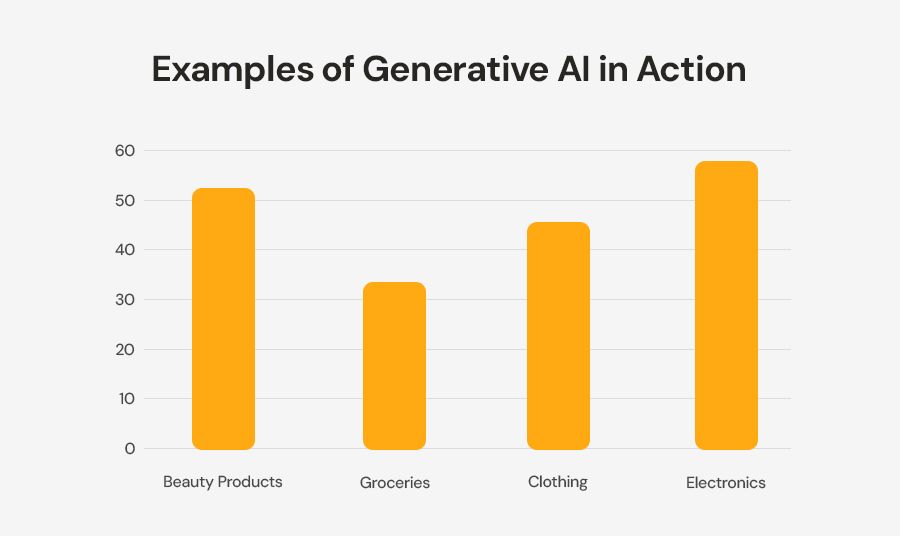
The retail industry is undergoing a transformation, and at the heart of this change is generative AI. With 75% of retail executives seeing, it as a primary driver of revenue, it's clear that this technology is more than just a trend. From personalized shopping experiences to efficient inventory management, generative AI is reshaping how retailers operate and interact with customers. But what exactly is generative AI, and how can it be implemented in retail? Let's explore the use cases, examples, and steps to bring this technology into your retail strategy.
Understanding Generative AI in Retail
Generative AI refers to artificial intelligence systems that use machine learning models, such as Generative Adversarial Networks (GANs) or transformers, to create new content. This content can include text, images, or even product designs, based on the data they are trained on. In retail, this means AI can generate personalized product recommendations, create marketing content, or even design new products. The potential is vast, and retailers are quickly realizing the benefits.
Why Retailers Are Investing in Generative AI

According to recent data, 93% of Chief Experience Officers (CxOs) plan to increase their spending on generative AI over the next 3-5 years. This investment is driven by the technology's ability to improve customer experiences, streamline operations, and boost revenue. With 50% of working hours in retail potentially affected by generative AI, the impact on efficiency and productivity is significant. Retailers are leveraging AI to automate repetitive tasks, analyse large datasets, and deliver insights that drive decision-making.
Use Cases of Generative AI in Retail
Personalised Shopping Experiences: Generative AI can analyze customer data, such as purchase history and browsing behavior, to create personalized product recommendations. For example, if a customer frequently buys beauty products, the AI can suggest new items based on their preferences and past purchases using collaborative filtering or neural network-based recommendation systems.
Inventory Management: AI can predict demand for products using time-series forecasting models, helping retailers manage inventory more effectively. This reduces overstocking and ensures popular items are always available, optimising supply chain operations.
Marketing and Advertising: Generative AI can create targeted marketing campaigns by analysing customer behaviour and preferences. Natural Language Processing (NLP) models can generate ad copy, while computer vision algorithms can create visually appealing content tailored to specific audiences.
Product Design: Retailers can use AI to generate new product designs based on current trends and customer feedback. Techniques like style transfer and generative design algorithms enable the creation of innovative products that align with market demands.
Customer Support: AI-powered chatbots, built on transformer-based models like GPT, can handle customer inquiries, providing instant support and freeing up human agents for more complex tasks. These chatbots can understand and respond to customer queries with high accuracy, improving overall service efficiency.
Examples of Generative AI in Action

Beauty Products: A beauty retailer uses generative AI to recommend skincare routines based on individual skin types and concerns. This personalized approach, powered by AI-driven analysis of customer data, increases customer satisfaction and loyalty.
Groceries: A grocery chain employs AI to predict which products will be in high demand during different seasons using predictive analytics. This ensures shelves are stocked with the right items at the right time, reducing waste and improving customer satisfaction.
Clothing: A fashion retailer uses AI to design new clothing lines by analysing current trends and customer preferences. Generative design algorithms help create collections that resonate with their target audience, speeding up the design process.
Electronics: An electronics store implements AI to create personalised shopping experiences, suggesting gadgets and accessories based on customers' previous purchases and browsing history. Collaborative filtering algorithms ensure that recommendations are relevant and timely.
Implementing Generative AI in Retail
To successfully implement generative AI, retailers should consider the following steps:
Identify Key Areas for AI Integration: Determine which aspects of your business could benefit most from AI, such as customer service, inventory management, or marketing. Conduct a thorough analysis of your operations to pinpoint areas where AI can add the most value.
Partner with an AI Development Company: Collaborating with an experienced AI development company can help you navigate the complexities of AI integration. These companies offer specialized AI development services to tailor solutions to your specific needs, ensuring that the AI models are trained on relevant data and aligned with your business objectives.
Collect and Analyze Data: AI systems rely on data to function effectively. Ensure you have robust data collection and analysis processes in place to feed your AI with accurate and relevant information. This includes cleaning and preprocessing data to remove noise and ensure high-quality inputs for your models.
Train Your Team: Equip your staff with the knowledge and skills needed to work with AI systems. This includes training on how to interpret AI-generated insights and integrate them into daily operations. Consider workshops or courses on AI fundamentals and specific tools used in your implementation.
Monitor and Optimize: Continuously monitor the performance of your AI systems using metrics like accuracy, precision, and recall. Make adjustments as needed to ensure your AI remains effective and aligned with your business goals. Regularly update your models with new data to maintain their relevance and accuracy.
The Future of Generative AI in Retail
As generative AI continues to evolve, its applications in retail will only expand. Retailers who embrace this technology early will have a competitive edge, offering superior customer experiences and operating more efficiently. By partnering with an AI development company and leveraging AI development services, retailers can unlock the full potential of generative AI and stay ahead in the ever-changing retail landscape.
In conclusion, generative AI is not just a futuristic concept; it's a practical tool that's already transforming the retail industry. From personalised shopping experiences to efficient inventory management, the benefits are clear. By understanding the use cases, learning from successful examples, and following a structured implementation plan, retailers can harness the power of generative AI to drive growth and innovation.
AI Solutions for Smarter Retail



